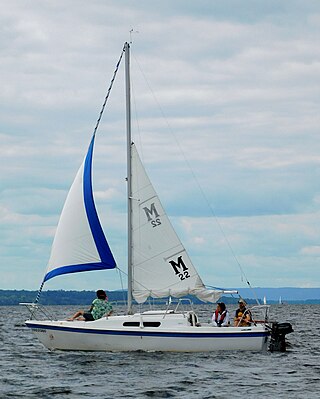Related Research Articles
The Columbia 24 Contender is an American trailerable sailboat that was designed by Joseph McGlasson in conjunction with Columbia Yachts and first built in 1963.
The Beneteau First 210 is a French trailerable sailboat that was designed by Groupe Finot and first built in 1992 as a cruiser-racer.
The Clipper 21, also called the Clipper Marine 21 and the Clipper Mark 21, is an American trailerable sailboat that was designed by William Crealock and first built in 1971.
The Dehler 22 is a West German trailerable sailboat that was designed by E. G. van de Stadt and first built in 1983. It is van de Stadt's design number 374.
The Ensenada 20 is an American trailerable sailboat that was designed by Lyle C. Hess as a cruiser and first built in 1972.
The ETAP 20 is a Belgian trailerable sailboat that was designed by E. G. van de Stadt as a cruiser and first built in 1975.
The ETAP 23 is a Belgian trailerable sailboat that was designed by Jacques de Ridder as a cruiser and first built in 1982.
The ETAP 23iL is a Belgian trailerable sailboat that was designed by Jacques de Ridder as a cruiser and first built in 1994.
The ETAP 28i is a Belgian sailboat that was designed by French designers Philippe Harlé and Alain Mortain (Harlé-Mortain), as a cruiser and first built in 1988.
The ETAP 32i is a Belgian sailboat that was designed by French designers Philippe Harlé and Alain Mortain (Harlé-Mortain), as a cruiser and first built in 1992.
The ETAP 26 is a Belgian trailerable sailboat that was designed by E. G. van de Stadt as a cruiser and first built in 1982.

The ETAP 34s is a Belgian sailboat that was designed by Mortain & Mavrikios as a cruiser and first built in 1997.
The ETAP 24i is a Belgian trailerable sailboat that was designed by Marc-Oliver von Ahlen as a cruiser and first built in 1999.
The ETAP 32s is a Belgian sailboat that was designed by Mortain & Mavrikios as a cruiser and first built in 2003.
The ETAP 26s is a Belgian trailerable sailboat that was designed by Marc-Oliver von Ahlen as a cruiser and first built in 2005.
The Freedom 24 is an American trailerable sailboat that was designed by William H. Tripp, III as a racer-cruiser and first built in 1994.
The Golif 21, or just Golif, is a French trailerable sailboat that was designed by P. Jouët & Cie as a pocket cruiser. It was named for the fictional pirate, Louis Le Golif and first built in 1961.

The MacGregor 22 is an American trailerable sailboat that was designed by Roger MacGregor as a cruiser and first built in 1967.
The Venture 22 is an American trailerable sailboat that was designed by Roger MacGregor as a cruiser and first built in 1968.
The Venture 222 is an American trailerable sailboat that was designed by Roger MacGregor as a cruiser and first built in 1971.
References
- 1 2 3 4 5 6 McArthur, Bruce (2020). "ETAP 22i sailboat". sailboatdata.com. Archived from the original on 25 March 2021. Retrieved 25 March 2021.
- ↑ McArthur, Bruce (2021). "Jacques de Ridder". sailboatdata.com. Archived from the original on 16 January 2021. Retrieved 25 March 2021.
- 1 2 3 4 5 6 7 8 9 Henkel, Steve: The Sailor's Book of Small Cruising Sailboats, page 168. International Marine/McGraw-Hill, 2010. ISBN 978-0-07-163652-0
- ↑ McArthur, Bruce (2021). "Etap Yachting". sailboatdata.com. Archived from the original on 23 March 2021. Retrieved 25 March 2021.
- ↑ McArthur, Bruce (2021). "Etap Owners Association". sailboatdata.com. Archived from the original on 23 March 2021. Retrieved 23 March 2021.